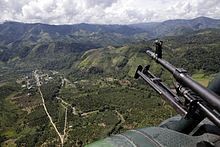Valle de los Ríos Apurímac, Ene y Mantaro
From Wikipedia, the free encyclopedia
Overlooking the VRAEM
Map of the Valle del ríos Apurímac, Ene y Mantaro
Active areas of the Shining Path guerillas.
A military base in the VRAEM
The Valle de los Ríos Apurímac, Ene y Mantaro ("valley of the Apurímac, Ene and Mantaro rivers"), also known as the VRAEM or VRAE, is a geopolitical area inPeru.[1] It is one of the major areas of coca-growing in Peru. The area is extremely poor.[2]
The VRAEM is an area of such high childhood malnutrition and poverty that the government of Peru selected the VRAEM to launch its National Strategy for Growth program in 2007.[3]
Cocaine production
Since 2012, Peru has overtaken Colombia as the worlds largest cocaine production country.[4][5] With local incomes below $10/day, and the natives having suffered from the Shining Path rebels, the valleys are used to produce raw paste product.[5][6] With an estimated 19,700 hectares (49,000 acres) of production area (2010), it is presently the world's densest area of cocaine production.[1][6] Paste product is shipped out of the valleys by armed native backpackers to Cuzco,[2][5] and then onward shipped to either: the Pacific Ocean ports; the Bolivian border, where it is sold to one of the drug cartels; or to mule-traffickers who ship the product onwards via scheduled air transport to Europe and North America.[5][6]





No hay comentarios:
Publicar un comentario